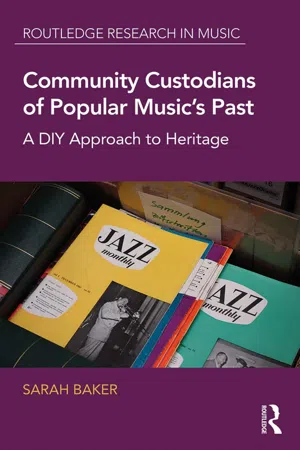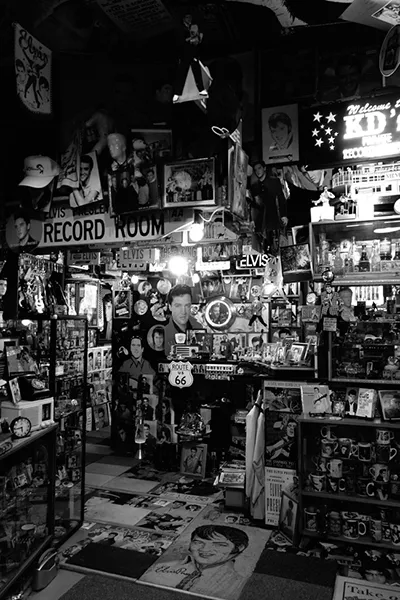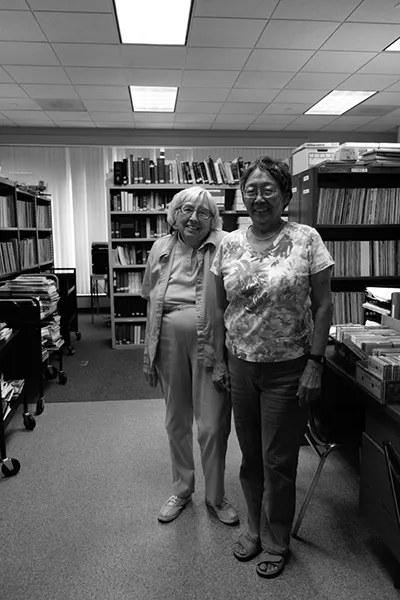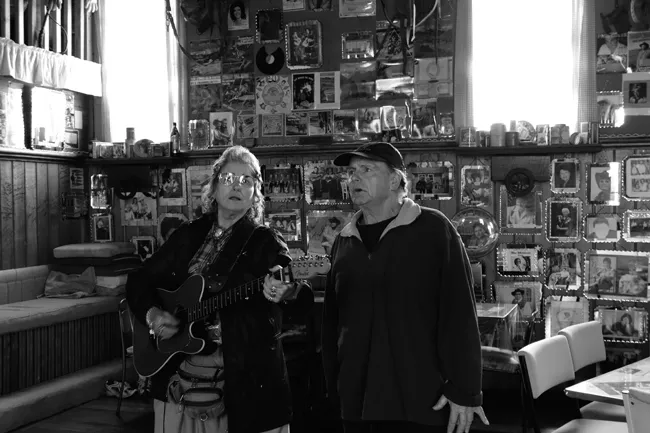![]()
1 The do-it-yourself approach to heritage
An introduction
If we forget the past we’re going to forget what made us.
(John, Sarasota Music Archive, 7 April 2014)
This book reflects on the ways in which enthusiast-founded, volunteer-led, community-based archives, museums and halls of fame are contributing to the public record of popular music’s material past. Individuals and communities are taking on the role of custodians of popular music heritage, producing archives, museums and halls of fame that are distinct and specific, but which reside on a continuum of popular music heritage practice at the community level. Places like KD’s Elvis Presley Museum (see Figure 1.1) and the Sarasota Music Archive (see Figure 1.2) are illustrative of this continuum. The first is a collection of Elvis memorabilia on display in the converted garage of founder-curator KD’s home in Hawera, New Zealand. The museum is open to the public by appointment and, in addition to the focus on Elvis, also tells the story of KD’s engagement with rock’n’roll throughout his life. The collection demonstrates the development in music players across time by including the devices on which KD played music in his teenage and adult years, as well as providing insight into New Zealand’s 1950s and 1960s rock’n’roll scene through a display of boots and jackets from his days immersed in that scene. The second is an archive devoted to the collection of all genres of music. Housed as an independent collection in a public library in Florida, United States, the Sarasota Music Archive is run by a sizeable group of volunteers who have significant autonomy in the management of the archive, despite its activities being overseen by a professional librarian.
While at first glance these places appear quite different, their intent is very similar. KD and the volunteers of the Sarasota Music Archive are all concerned with preserving popular music’s material past for future generations. This mission is captured in the chapter’s opening words from John, a Sarasota Music Archive volunteer, who emphasizes the importance of remembering music’s past. Moreover, like all the archives, museums and halls of fame discussed in this book, KD’s Elvis Presley Museum and the Sarasota Music Archive both ascribe to a do-it-yourself (DIY) approach to heritage, in which popular music’s material past is managed, preserved and curated by ordinary people in extraordinary ways.
Figure 1.1 KD’s Elvis Presley Museum is located in the garage of KD’s home in Hawera, New Zealand.
Source: Photo by Sarah Baker.
Figure 1.2 Joan and Beverly, volunteers at the Sarasota Music Archive housed in the Selby County Library in Florida, United States.
Source: Photo by Sarah Baker.
The need to preserve artifacts of the recent past for future generations has been keenly felt in the field of popular music. Enthusiasts have identified a pressing need to archive the remnants of popular music’s material past to safeguard the national and local histories of this important cultural form. Traditionally, popular music cultures were not regarded as heritage: as Bennett (2015, 18) argues, the “mass-produced, commercial and global cultural properties [of popular music artifacts] rendered them the antithesis of anything deemed to be of authentic historical and cultural value as this was conceived in conventional heritage discourse.” Over time, there has been a gradual shift in the priorities of the heritage sector; the collection and curation of formal evidence of statehood, modernity and other central aspects of regional or national life now balances with a fiscal and administrative responsibility for the preservation of popular culture, including popular music (Baker, Doyle and Homan 2016). National archives and museums have thus emerged as institutions which carry a responsibility to preserve the material aspects of popular music heritage.
Many countries now have national museums and archives dedicated to the collection, preservation and display of popular music; these institutions often seek to provide a level of public access to their collections. In the United Kingdom, for example, the British Library Sound Archive houses one of the world’s largest collections of sound recordings as well as a reference collection of printed materials and historic playback equipment. Comparable institutions, for example, include the National Film, Video and Sound Archives, a sub-directorate of the National Archives and Records Service of South Africa and the National Sound Archive at the National Library of Israel. As a repository for national heritage, an institution like the National Film and Sound Archive in Australia is accordingly supported by federal funding and an institutional structure designed to meet the aims of collection, preservation, promotion and access. But in the recognition that it is virtually impossible for such institutions to collect everything and to function as comprehensive repositories of the nation, collecting strategies often lean towards the pursuit of selective narratives of particular national significance. Moreover, the majority of such institutions focus on the archiving of sound rather than the collection of artifacts from popular music cultures more broadly. As a result, the selection of materials and sounds of popular music in national institutions tends to reinforce existing canons by following established narratives of popular music histories (Baker, Doyle and Homan 2016).
Brandellero and Janssen (2014, 225) note that “in recent years, spurred by the growing status and recognition of intangible heritage, bottom-up approaches to heritage identification have emerged, legitimating the role of communities as bestowers of heritage status.” As a result, alongside prestigious national institutions such as those mentioned above, there exists a range of community-led, grassroots, specialist archives, museums and halls of fame which are equally important to the preservation of popular music’s material past. Although some of these places have developed broad collection remits, others are dedicated to specific genres, artists or locales which are marginalized, or at least not the focus of national collections, and which operate largely without any form of significant government support. Such institutions tend to have limited paid staff and rely for their operation sometimes entirely on the work of volunteers or interns. Indeed, many such institutions have no paid workforce whatsoever, and no workers who have undertaken professional training in the areas of archiving and curating. These archives, museums and halls of fame are therefore important in epistemological terms because the parameters of their heritage practices are determined by the volunteers and enthusiasts involved in the day-to-day operations of these places, which enables archival records and museal exhibitions to be created which depart, sometimes significantly, from those that are governed by the policies and fiscal constraints of national institutions. The development of these grassroots archives, museums and halls of fame is part of a broader trend in which enthusiasts show interest in asserting ownership over, and expertise in, the cultural history of popular music. This leads them to acts of heritage management that contribute to our collective memory of these musics. Such places, therefore, have the potential to democratize popular music heritage, “contributing to a national archive that exists beyond the National Archives” (Flinn 2010, n.p.).
This book is concerned with popular music heritage as both practice and process, inasmuch as “its meanings and uses are socially, spatially and temporally enacted, and, as such, are constantly being remade and renegotiated” (Roberts 2014, 267). Thus, the question becomes not one of why it is important to amass the ephemera of popular music cultures in archives and museums (see Chapter 3, this volume) or revere canonic figures of the music industry in halls of fame (see Baker and Huber 2013b), but rather what does the DIY approach to heritage offer the people involved in establishing these grassroots institutions and the networks and communities of interest that form and are formed by them. As Roberts puts it:
rather than attempting to sketch the manifold heritages that attach themselves – with varying degrees of coherence – to forms of popular music culture, it is more instructive to pay critical attention to the discursive and performative structures of meaning and practice by which they are constituted … By breaking down music heritage discourses into the spaces, practices and “acts of transfer” that play performative host to the cultures of popular music pasts, we can gain a better understanding of how these pasts, in all their colour, diversity and authenticity, are lived in the present.
(Roberts 2014, 276–277)
This book demonstrates some of the ways in which popular music’s past becomes enacted in the present through the space of community-based archives, museums and halls of fame. It does this by drawing on a qualitative study of twenty-three1 enthusiast-founded, volunteer-led, community-based archives, museums and halls of fame the author visited between 2010 and 2015 as part of two consecutive projects funded by the Australian Research Council, Popular Music and Cultural Memory (DP1092910, 2010–12) and Do-It-Yourself Popular Music Archives (DP130100317, 2013–15). During this six-year period, interviews were conducted with 125 people contributing in various ways to these heritage enterprises, most of whom were volunteers. The sites of popular music heritage that are the focus of the book are located in ten countries – Australia, Austria, the Czech Republic, Germany, Iceland, the Netherlands, New Zealand, Switzerland, the United Kingdom and the United States. Such a spread begins to show the breadth of this type of heritage activity, and these twenty-three case studies are further contextualized with reference to other community-based heritage sites around the world. The archives, museums and halls of fame that are the focus of the book will be introduced in the following chapter (this volume).
This introductory chapter (this volume) sets the scene for what follows by providing an overview of the small but growing body of existing literature that has been adopted as a critical framework for the examination of grassroots popular music archives, museums and halls of fame. In particular, the reader’s attention is directed to the work of Roberts and Cohen (2014) on “self-authorized” and “unauthorized” popular music heritage practices, Bennett’s (2009) notion of a “DIY preservationist sensibility” and Flinn’s (2007) conception of the “community archive.” My work with Alison Huber (Baker and Huber 2013a) on “DIY institutions” is also outlined in the context of the professional-amateur “revolution” (Leadbeater and Miller 2004) and with reference to “communities of practice” (Wenger 1998).
Preserving popular music heritage: a continuum of practice
This section considers at length the contribution of Roberts and Cohen (2014) to an understanding of popular music heritage as a continuum of practice. By focusing on commemorative plaque schemes in England, Roberts and Cohen draw on qualitative research to propose “a critical and analytical framework through which to explore popular music heritage” (2014, 242). This framework sets out to avoid a binarism that positions popular music heritage practice as either official (top down) or unofficial (bottom up). Rather, they put forward a more nuanced critical framework that highlights three types of interrelated discourse about popular music heritage: officially authorized, self-authorized and unauthorized. Such a typology, they argue, enables an exploration of the dynamics of popular music heritage “as a situated, relational practice involving various, often contested negotiations of the musical past” and the analysis of “the various ways in which popular music heritage is not simply practised but also authorised and ascribed with value, legitimacy and social and cultural capital” (2014, 243).
In their typology, officially authorized popular music heritage (or “big H” Heritage) tends to be that which is sanctioned by or substantially sponsored by government bodies. At the other end of the spectrum is the third category in Roberts and Cohen’s typology, a variant of heritage practice that does not seek authorization and in which the emphasis is on everyday practice, cultural bricolage, anti-heritage, and individual and collective memory; this is unauthorized, “small h” heritage – a form of heritage practice that tends to exist “without even an awareness that it is heritage” (2014, 17, original emphasis). The middle ground, self-authorized popular music heritage, is where the types of places that are the focus of this book had their beginnings, and the majority still exist in this space.
With self-authorized popular music heritage, there tends to be limited official government backing and an absence of the “gilt-edged symbolic capital” that is attached to prominent public institutions (Roberts and Cohen 2014, 248). Rather, self-authorized sites, organizations and activities are established alongside their more prestigious counterparts by way of the music and media industries, and “by musicians, audiences, entrepreneurs and organisations who participate in particular musical cultures” (2014, 248). Roberts and Cohen refer to these as “DIY, localised or vernacular popular music heritage discourses,” which – although not officially authorized in the same way as prestigious public institutions – still make “claims to (or solicitations of) some form of official status” with regard to their “marketing and publicity, or ensuring the sustainability and development of the heritage initiative or resource in question” (2014, 248). Mechanisms through which self-authorized initiatives can build more influence and cultural clout include: the endorsement or patronage of famous or influential people, such as celebrities; the capacity to secure grants and other forms of public funding; and the ability to be granted charitable status – all of which can assist in lending an air of professionalization to the activities of the initiative and thus further blurring “the distinction between ideas of official and ‘unofficial’” popular music heritage (2014, 250).
In addition, while self-authorized institutions and practices may represent a more democratized form of popular music heritage, this type of activity memorializes “the personal musical heritage and history of individuals,” such as the founders of these initiatives, as much as “that which is claimed on behalf of a wider group or nation” (Roberts and Cohen 2014, 250). This is evident in the example of KD’s Elvis Presley Museum but is also highlighted in the Taranaki Country Music Hall of Fame in Manaia, New Zealand. This private museum is centered on a collection of over 400 images of country music musicians which, as its brochure states, aims to bring visitors “face to face with the Country Music legends of our time” and “bring back memories of the good ol’ days singing around the piano.” The owner-curators of the museum, Helen and Ian, are both keen musicians and the Hall of Fame provides them with opportunities to bring the space of the museum alive with the music that has been the soundtrack of their lives (see Istvandity 2014, 136) (see Figure 1.3). Self-authorized popular music heritage practice concerns, to some degree, the enactment of memory. As Roberts and Cohen (2014, 252) explain, “One of the chief functions of self-authorizing music heritage practices is, therefore, to furnish a means by which to give substance to the ritual and performative dimensions of cultural memory: the sites of popular music heritage as an (in)tangible place of pilgrimage” and also “the experiential, affective and embodied contours of musical memory.”
Figure 1.3 Helen and Ian, owner-curators of the Taranaki Country Music Hall of Fame in Manaia, New Zealand, performing “Teen Angel.”
Source: Photo by Sarah Baker.
The work of Roberts and Cohen (2014) highlights the importance of thinking about popular music heritage activities on a spectrum. Such thinking expands our understanding of community-led heritage endeavors, enabling the inclusion of what might be described, using Roberts and Cohen’s proposed framework, as the “unauthorized” heritage initiatives of someone like Yashiv Cohen in Israel, who founded a music history lecture series in Tel Aviv bars, to the self-authorized practices of an organization like the British Archive of Country Music in England; this also extends to those institutions that have amassed a level of authority which sees them on the verge of achieving a broader public acceptance comparable with...



